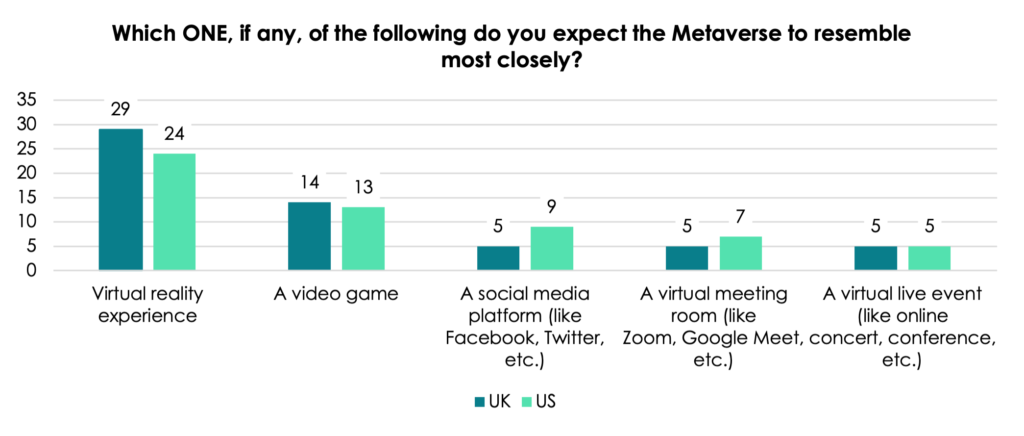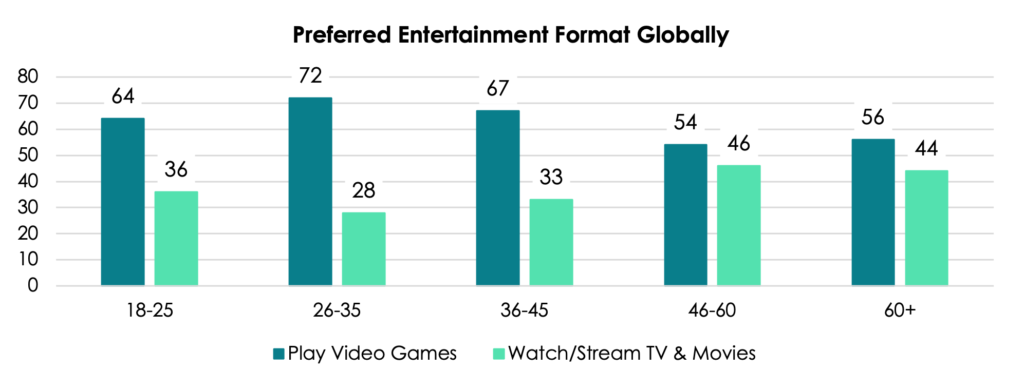By Maria Bain, Head of Audience Intelligence, iCrossing UK
The Metaverse. The latest hype trend taking the digital advertising industry by storm, but does anyone really understand what it is and what potential it holds for brands?
So, what exactly is the Metaverse?
We’ve all read something along the lines of ‘The Metaverse is immersive and social. It’s the next evolution of the internet experience, which enables people to move beyond browsing the web towards participating in or even inhabiting a shared experience that spans the spectrum of our real world to a fully virtual world’.
But, what does that actually mean?!
Simply put, the Metaverse is a virtual reality world where users can interact, game and experience things as they would in the real world.
Now, many Metaverse experiences are still in early stages of development and adoption. We’re only just seeing the tip of the iceberg of possibilities – from the first iterations of virtual worlds to entertainment-led VR/digital events, to owning digital real estate.
According to YouGov’s 2022 research on the Metaverse that analysed the UK and US attitudes towards the buzzy new technology; most audiences across both markets believe that the Metaverse is largely a virtual reality experience, and they aren’t too far from the truth. Virtual reality is certainly an element of the Metaverse, but it’s also so much more.

To understand the potential opportunities the Metaverse holds for brands we’ve leveraged the analogy of Paid Social – bear with us, it will all make sense!
Paid social is comprised of numerous social platform ecosystems – we use the phrase ‘paid social’ to encompasses paid media advertising across the likes of Meta, Pinterest, TikTok and Snapchat. The Metaverse similarly is comprised of numerous virtual platform ecosystems such as Decentraland, The Sandbox, Roblox and Horizon Worlds. The term ‘Metaverse’ for the moment is simply the word to group the wonderful variety of virtual worlds that people are entering daily.
Makes sense, but why should brands care?
The opportunity across the Metaverse for brands in simple: To have a brand presence within Metaverse ecosystems that key target audiences frequent.
Using our paid social example again here, if one of our clients key target audiences was crafty mums we might discern through our audience intelligence research that crafty mums spend 3h a day scrolling and searching on Pinterest looking for inspiration and planning their next DIY project.
You would want to have brand visibility and representation on Pinterest then wouldn’t you? As this is a place digitally that your target audience is spending a lot of time? Your digital agencies recommendation would then clearly be to build or increase brand visibility and relevancy across Pinterest – an environment that your audiences spends time in and their mindset and affinity interests match your brands.
In the case of the Metaverse the theory is the same. Say your target audience is frequent travellers, and our audience intelligence identifies that this audience identity spends 3 hours a day wandering around and playing in Decentraland looking for entertainment, connections, and excitement. You would want to have brand visibility, relevancy and representation on this platform, right? And your agencies recommendation might then be to launch or increase brand visibility across an environment that your key target audience spends time in.
And how do brands decide which Metaverse worlds to enter?
Just like we spot audience opportunities across Paid Social channels to target and engage high value client identities, we can do the same across the Metaverse.
When we carry out audience intelligence research, to identify the best social ecosystem for our clients, we pull the following three lenses of research together to evidence the right selection of paid social channels:

Our data and insights answer questions around:
- Which social media channels our clients audience identities frequent
- Why these audiences are on the platforms and what they engage with
- What their mindsets are when they are on the platforms
- Who these users are and what digital identities they sit within
- What these users affinity interest are and which are relevant to the culture around our clients brand
And just like we pull this data and insight for social channels, we can do the same for the digital worlds within the Metaverse. Identifying where client audiences are spending their time online.
Okay, that’s interesting, but isn’t the Metaverse for gamers?
The Metaverse was born out of gaming. Gamers already spend $100 Billion annually on virtual goods. 3 billion people play video games, that’s more than a third of the world’s population regularly playing video games. And it’s not just a man’s game, 46% of gamers are women. And even more interestingly; across generations gaming has also becoming the leading preferred entertainment format globally. More people enjoy playing games then watching TV! Imagine how many hours a day in the Metaverse people are spending that you could reach them?

The Metaverses heritage in gaming is obvious, but the opportunities across industries are starting to emerge. According to YouGov research, socialising and destination experiences have also emerged from the activities early Metaverse adopters are interested in pursuing, with 52% of UK and US users looking to enter the Metaverse to meet up with friends and 40% to visit a destination.
Screenwear is the new streetwear for fashion brands across the Highstreet to luxury spectrum – with the likes of River Island and Forever 21 selling physical clothes with digital twins in Roblox, to Balenciaga selling digital outfits in Fortnite and Burberry doing the same in Tencent Games.
Virtual concerts are making waves – with the likes of Justin Bieber’s interactive concert in Wave, Ariana Grande’s Fortnite concert and Twenty One Pilots’ Roblox experience. And carnivals are kicking off with the likes of Paris Hilton hosting the Neon Carnival experience in the Metaverse in Paris World on the online gaming platform Roblox, giving the public an inside look at the exclusive event for the first time.
Sounds exciting! But what should my brand be doing in the Metaverse?
This all sounds exciting for the music, events and fashion industries, but what is the purpose of the Metaverse for brands within the travel, finance, education, experience, and pharma industries now?
To occupy the field…
Many brands believe in the potential of the Metaverse. Current opportunities and investments should be aimed at “occupying the field”. As in real life, brands should look to purchase potentially strategic locations ahead of their competitors to provide a competitive advantage in the future.
The Metaverse isn’t limitless as people might think; supply of land on The Sandbox and Decentraland (two of the most famous Metaverses) is already restricted due to demand.
As in real life, brands should look to purchase potentially strategic locations to give them a competitive advantage in the future. The reasoning behind this is a “first-mover advantage.”
Learning…
All industries are at the beginning of their learning curve beyond the strategy of occupying the virtual terrain found in other sectors. Brands current presence in the Metaverse should be focused on “dipping their toe in”. Experimenting with new ways of delivering value to their customers.
Many brands already feel that experimentation costs are still low compared to what they could become in the future. The Metaverse is still in its infancy today, and in the absence of pressure, it is still easy to test without having to meet specific targets.
Brand Image…
Brand investments in the Metaverse also serve image objectives. The Metaverse is intimately linked to NFTs, the crypto universe, and consequently to the younger generations. Appealing to a younger generation is going to be key to the continued success of all industries. Using a presence in the Metaverse to demonstrate your modernity would be a clever segment of a marketing strategy, engaging the “early adopters.”
So, to summarise:
We need to acknowledge that if the ecosystems within the Metaverse become the meeting place for brands potential clients and customers, it could even become a new onboarding channel. The Metaverse isn’t just one platform (yet!), but a number of currently siloed universes that we need to gain a better understanding of. When we understand what types of people are spending time in these universes brand opportunities will become clearer.
A new digital era is here, we need to find creative ways to make the most of it in terms of learning, audience experience, and relevant brand visibility. Here at iCrossing we’re starting to explore audience identity propensities to spend time in Metaverse ecosystems like Decentraland, The Sandbox, Roblox and many more. Our aim is to better understand the users across these ecosystems to find purposeful and relevant brand opportunities to reach and engage their most valuable audiences; just like we do across Paid Social.






